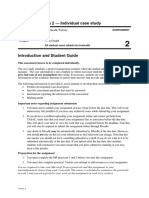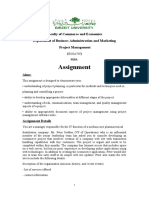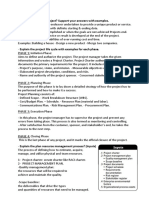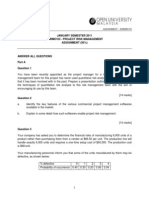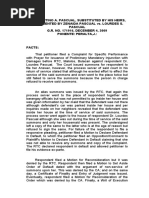Assignment Project Management
Uploaded by
Nazmul HudaAssignment Project Management
Uploaded by
Nazmul Huda1
TABLE OF CONTENTS
1. Introduction --------------------------------------------------------------02 2. Action Plan for Building a Cell Phone Tower ----------------------02 3. Description of Activity --------------------------------------------------03 4. Gantt Chart ---------------------------------------------------------------04 5. Project Network (using Activity on Node-AON) ------------------05 6. Calculation of Critical path --------------------------------------------05 7. Slack calculation ---------------------------------------------------------05 8. Project scheduling (PERT analysis) ----------------------------------07 9. Cost/Time trade-off: Crashing ----------------------------------------09 10.Conclusion ----------------------------------------------------------------13
Building a Cell Phone Tower
1.1) Introduction:
Being a project management student we have been assigned to submit a project proposal on constructing a Cell Phone Tower within the given period of time and resources. As we know the goals of project management should be performance based, time savings and cost effective, our ultimate goal for this project will be the same. From the definition we know project is the part of an overall program. A program is an exceptionally large long range objective thats broken down into a set of projects. The purpose of this project is to provide sound network coverage in the selected zone. The vital characteristics of a perfect project are projects exits for limited amount of time, having a definite starting and ending date, getting an opportunity to bring together the talents and skills of a wide group of people and so on. We think our project fulfill the entire basic requirement for being a perfect project.
1.2) Action Plan for Building a Cell Phone Tower:
Activity ID A Activity Name Predecessors Start Time End Time Duration (Days) 4 Cost (In TK. ,000) 50
E F G
Finalize the tower sketch and design Selecting location and getting permission Collection of hardware and accessories Hire engineer, worker and manage electricity supply Constructing the base tower Assembling hardware Activating the tower
None
01/04/2013
04/04/2013
05/04/2013
09/04/2013
100
05/04/2013
11/04/2013
700
B, C
12/04/2013
14/04/2013
10
D D E, F
15/04/2013 15/04/2013 22/04/2013
21/04/2013 18/04/2013 23/04/2013
7 4 2
35 10 5
1.3) Description of each activity:
i) Finalize the tower sketch and design (A): The first activity of this project is to make a proper design of the tower. How much strong and tall the tower will be at the end of the day that will be focused by this final design. ii) Selecting location and getting permission (B): The second most important activity is selecting location and getting permission from the land/building authority. We have to choose the best location for this purpose. iii) Collection of hardware and accessories (C): After Selecting location and getting permission we have to concentrate on the collection of hardware and accessories that is server, Mobile Switching Center (MSC), transmitter, microwave antenna and other required raw materials. Here timing of delivery and quality of materials are very much important. iv) Hire engineer, worker and manage electricity supply (D): After assuring about the timing of delivery and quality of product, it is thought to be hired engineer, worker and manage electricity supply. Because this project is basically dependent on the efficient engineer, worker. v) Constructing the base tower (E): In this step, according to the final sketch and design of the tower, engineer and worker constructing the base tower. vi) Assembling the hardware (F): Now according to the final design of server, Mobile Switching Center (MSC), transmitter, microwave antenna will be assembled. vii) Activating the tower (G): This is the last step of our assigned project. After checking all the equipment and ensuring that the system is successfully connected with the main network we will activate the transmission of signal. Through this step our assigned project will be terminated.
1.4) Gantt chart:
The Gantt chart shows planned and actual progress for a number of tasks displayed against a horizontal time scale. It is an effective and easy-to-read method of indicating the actual current status for each set of tasks compared to the planned progress for each item of the set. But Gantt charts usually do not show technical dependencies.
GANTT CHART
DATE
03/04/2013 04/04/2013 05/04/2013 06/04/2013 09/04/2013 10/04/2013 11/04/2013 12/04/2013 13/04/2013 14/04/2013 15/04/2013 16/04/2013 17/04/2013 19/04/2013 20/04/2013 21/04/2013 22/04/2013 23/04/2013 07/04/2013 08/04/2013 18/04/2013
01/04/2013
A B C D E F G
02/04/2013
Activi ty ID
1.5) Project Network (Using Activity on Node-AON) (Figure:1):
Figure:1 1
B=5
E=7
Start
A=4
D=3
G=2
Finish
C=7
F=4
1.6) Calculation of Critical Path:
Critical path means the longest path that determines expected project duration. Longest path treated as the critical path. From the above project network, these are the probable path, i) ii) iii) iv) ABDEG= 4+5+3+7+2= 21 days ABDFG= 4+5+3+4+2= 18 days ACDEG= 4+7+3+7+2= 23 days ACDFG= 4+7+3+4+2= 20 days
From the above probable path, the longest path is ACDEG= 23 days. So ACDEG is the critical path of the project.
1.7) Slack Calculation:
Slack is the allowable slippage for path that is the difference of the length of path and the length of critical path. So normally slack means how many days can an activity be delayed without affecting project life. It is very easy to calculate slack that is late start time minus early start time or late finish time minus early finish time. That means
slack = LST - EST or LFT EFT. Also we know that the activities which have 0 slack are on critical path. From the above data and the following figure we can easily calculate the slack of each EFT EST activity; those are given in following table: (Figure: 2)
Figure: 2
4 B=5
14 E=7
21
LST
LFT
6 0 Start 0 A=4 4
11 11 D=3 14
14
21 21 G=2 23 Finish 23
4 4 C=7 11
11
14 14 F=4 18
21
11
17
21
Activity A B C D E F G
LST-EST 0-0=0 6-4=2 4-4=0 11-11=0 14-14=0 17-14=3 21-21=0
LFT-EFT 4-4=0 11-9=2 11-11=0 14-14=0 21-21=0 21-18=3 23-23=0
Slack 0 2 0 0 0 3 0
Critical Path* * * * * *
From the earlier calculation, we observed that all activity of the critical path having the zero slack. Activity B and F having slack 2 & 3 that means B and F can delay by 2 or 3 days without hampering the project life path.
1.8)
Project Scheduling (PERT Analysis):
PERT, Elaboration form is Program Evaluation and Review Technique. The critical path analysis is well suited to projects that are repetitive in nature or involve activities whose duration times can be estimated with relative certainty. Some other projects, in practice, have activities whose duration times may not be known with much degree certainty. A method that designed to treat activity duration times as random variables is called Program Evaluation Review Technique (PERT).
Activity times in PERT:
Each activitys duration time is considered to be a random variable. PERT assumes that this random variable has a beta probability density. There may be in three situations. The notation of those situations is given below: O= the optimistic time M= the most likely P= the pessimistic time We know the formula of calculating Mean,
Te= To+4Tm+Tp
6
Where, Te= Expected time To= Optimistic time Tm= Most likely time Tp= Pessimistic time
We also know that the formula of Variance,
(Tp-To)
36
2
Where,
2= Variance To= Optimistic time Tp= Pessimistic time
Activity ID A B C D E F G
Predecessors None A A B, C D D E,F
O (To) 2 3 4 1 4 2 1
M (Tm) 3 4 6 3 6 3 2
P (Tp) 5 6 9 4 9 5 3
Mean 3.17 4.17 6.17 2.83 6.17 3.17 2
Variance 2 0.25 0.25 0.69 0.25 0.69 0.25 0.11
Using the mean values of the activities we can draw the network as following: (Figure: 3)
Figure: 3 3.17 7.34 B=4. 17 5.17 0 Start 0 3.17 A=3. 17 3.17 3.17 C=6. 17 3.17 9.34 9.34 9.34 9.34 9.34 12.17 D=2. 83 12.17 12.17 15.34 F=3. 17 15.17 18.34 12.17 18.34
E=6.1 7 12.17 18.34 18.34 G=2 20.34 Finish 20.34
18.34
Using the mean activity times, we construct the pert network and calculate the slack.
Calculation of Slack:
Activity ID A B C D E F G LST-EST 0-0=0 5.17-3.17= 2 3.17-3.17= 0 9.34-9.34= 0 12.17-12.17= 0 15.17-12.17= 3 18.34-18.34=0 LFT-EFT 3.17-3.17 =0 9.34-7.34= 2 9.34-9.34= 0 12.17-12.17= 0 18.34-18.34=0 18.34-15.34= 3 20.34-20.34=0 Slack 0 2 0 0 0 3 0 Critical Path* * * * * *
From the above table and network the critical path has found as ACDEG. The critical path time is a normal random variable. This mean expected project completion time is 20.34 days. Now we have to calculate Path Probabilities, W know the formula
Where, Specified time = If 23 days, Path Mean = (3.17+6.17+2.83+6.17+2) = 20.34 Standard deviation of critical path time,
So the Z value will be,
From the z table we find the value of Z=1.18 is 97.06%. It says that there is a possibility 97.06% of being finished the project activity by 23 days.
1.9) Cost/Time trade-off: Crashing:
The main objective of crashing the project is shortened the projects duration by increasing the amount of money spent on the project. In the following table we specify the activities of a certain project. The normal time and normal cost for an activity are the time and cost incurred if the activity is executed at normal rate. The crash time and crash cost for an activity are the time and cost incurred if the activity executed as fast as possible. Incremental cost is calculated as follows:
10
Activity ID A B C D E F G Total
Predecessors None A A B, C D D E,F Time 4 5 7 3 7 4 2
Normal Cost 50 100 700 10 35 10 5 910 Time 3 4 5 2 5 3 1
Crash Cost 60 125 750 15 50 12 7 1019
Incremental Cost* 10 25 25 5 7.5 2 2
The normal schedule is following network that results from using normal time and normal cost for each activity. (Figure: 4)
Figure: 4 B=5 E=7
Start
A=4
D=3
G=2
Finish
C=7
F=4
Thus if we use normal time and cost, the project will be completed in 23 days at a cost of Tk.9,10,000.00
The crash schedule:
The crash schedule is the network that results from using crash time and crash costs for each activity. Crashing normal schedule is given below: (Figure: 5)
Figure: 5 B=4 E=5
Start
A=3
D=2
G=1
Finish
C=5
F=3
11
In our problem the critical path is A-C-D-E-G. The cost to crash each of these by one day are 10 for A, 25 for C, 5 for D, 7.5 for E & 2 for G. Now we choose to crash G by 1 day. In this case activity G, it cant be crashed further because it reached the crash point. (Figure: 6)
Figure: 6 B=5 E=7
Start
A=4
D=3
G=1*
Finish
C=7
F=4
The critical path is A-C-D-E-G. The cost to crash each of these are by one day 10 for A, 25 for C, 5 for D, & 7.5 for E. Now we choose to crash D by 1 day. In this case activity D, it cant be crashed further because it reached the crash point. (Figure: 7)
Figure: 7 B=5 E=7
Start
A=4
D=2*
G=1*
Finish
C=7
F=4
Again, the critical path is A-C-D-E-G. The costs to crash each of these by one day are 10 for A, 25 for C & 7.5 for E. Now we choose to crash E by 1 day. In this case activity E, it can be crashed further because it has not reached the crash point. (Figure: 8)
Figure: 8 B=5 E=6
Start
A=4
D=2*
G=1*
Finish
C=7
F=4
12
As activity has not reached at crash point, it has to be crashed further. So we will see it in new network (Figure: 9):
Figure: 9 B=5 Start A=4 C=7 D=2* F=4 E=5* G=1* Finish
Again, the critical path is A-C-D-E-G. The cost to crash each of that by one day are 10 for A & 25 for C. Now we choose to crash A by 1 day. In this case activity A, it cant be crashed further because it reached the crash point. (Figure: 10)
Figure: 10 B=5 E=5*
Start
A=3*
D=2*
G=1*
Finish
C=7
F=4
Now it is time for to crash only activity C in new network, but Activity C can be crashed further,( Figure: 11)
Figure: 11 B=5 Start A=3* D=2* E=5* G=1* Finish
C=6
F=4
Again activity C is crashed in new network and then all activity in critical path reached their crash limit. (Figure: 12)
Figure: 12 B=5 Start A=3* D=2* E=5* G=1* Finish
C=5*
F=4
13
Cost of final schedule:
Description Normal schedule Cost G crashed 1 day at 2000 D crashed 1 day at 5000 E crashed 2 day at 7500/ day A crashed 1 day at 10000 C crashed 2 day at 25000/day Total Amount TK. 9.10,000 2,000 5,000 15,000 10,000 50,000 TK. 9,92,000
Calculation of Net Benefit:
Normal crash schedule =TK. 10,19,000 9,92,000 27,000
Minimum crash schedule =TK. Savings = TK.
1.10) Conclusion:
We are confident that our proposed project is very much realistic. We also believe that this project is very much competitive in the current market. We hope this project will be accepted by the higher authority and finally it will add value to the business.
14
You might also like
- Topic 1 Introduction To Project Management PDFNo ratings yetTopic 1 Introduction To Project Management PDF3 pages
- Project Management Report On Bike Assembly PlantNo ratings yetProject Management Report On Bike Assembly Plant16 pages
- Mid Term Assignment (Case Study Project Management)No ratings yetMid Term Assignment (Case Study Project Management)7 pages
- Murdoch University Bsc203 Introduction To Ict Research Methods Project Management PortfolioNo ratings yetMurdoch University Bsc203 Introduction To Ict Research Methods Project Management Portfolio11 pages
- Recursive Form of The Eigensystem Realization Algorithm For System IdentificationNo ratings yetRecursive Form of The Eigensystem Realization Algorithm For System Identification6 pages
- Project Management Standards, Tools and Techniques - Group Assignment-1No ratings yetProject Management Standards, Tools and Techniques - Group Assignment-112 pages
- Assignment: Faculty of Commerce and Economics Department of Business Administration and Marketing Project ManagementNo ratings yetAssignment: Faculty of Commerce and Economics Department of Business Administration and Marketing Project Management5 pages
- Lecture 8: Risk Management: Software Development Project Management (CSC4125)No ratings yetLecture 8: Risk Management: Software Development Project Management (CSC4125)51 pages
- Chapter 4 - Project Integration ManagementNo ratings yetChapter 4 - Project Integration Management92 pages
- UNIT-I Project Management and Selection CriteriaNo ratings yetUNIT-I Project Management and Selection Criteria15 pages
- Knowledge Area Quiz Project Communications Management Practice Questions-Answer Key and ExplanationsNo ratings yetKnowledge Area Quiz Project Communications Management Practice Questions-Answer Key and Explanations3 pages
- Assignment - PM0011 - Project Planning and Scheduling - Set 2No ratings yetAssignment - PM0011 - Project Planning and Scheduling - Set 211 pages
- LO#1 Establish Project Aims, Objectives and Timeframes Based On Chosen ThemeNo ratings yetLO#1 Establish Project Aims, Objectives and Timeframes Based On Chosen Theme101 pages
- Module 2: Project Management Overview Project Management Overview and DefinitionNo ratings yetModule 2: Project Management Overview Project Management Overview and Definition2 pages
- 6 - Week 5-Case Study-Project Integration ManagementNo ratings yet6 - Week 5-Case Study-Project Integration Management2 pages
- Chapter 3 Project Identification and FeasibilityNo ratings yetChapter 3 Project Identification and Feasibility80 pages
- Acclaim Series 10 Fire Extinguishing PanelNo ratings yetAcclaim Series 10 Fire Extinguishing Panel6 pages
- Project Management - Initiating ProjectsNo ratings yetProject Management - Initiating Projects40 pages
- 1.1 Introduction To Software EngineeringNo ratings yet1.1 Introduction To Software Engineering25 pages
- The Bcs Professional Examinations BCS Level 5 Diploma in IT October 2009 Examiners' Report IT Project Management Section ANo ratings yetThe Bcs Professional Examinations BCS Level 5 Diploma in IT October 2009 Examiners' Report IT Project Management Section A10 pages
- Agile Methodology: The Main Advantages of 'Agile' AreNo ratings yetAgile Methodology: The Main Advantages of 'Agile' Are6 pages
- Attock Sunset Testing Report (PTA Format)No ratings yetAttock Sunset Testing Report (PTA Format)1 page
- The Possibility of An Afterlife As Examined Through Near-Death ExNo ratings yetThe Possibility of An Afterlife As Examined Through Near-Death Ex15 pages
- Bio Factsheet: The Paired T-Test & When To Use ItNo ratings yetBio Factsheet: The Paired T-Test & When To Use It3 pages
- PDF Download For JEE Advanced Previous Year Questions With Solutions On GravitationNo ratings yetPDF Download For JEE Advanced Previous Year Questions With Solutions On Gravitation7 pages
- Compare and Contrast Essay Thesis Statements100% (3)Compare and Contrast Essay Thesis Statements6 pages
- Tamil Daily Calendar 2024 - 2005 தமிழ் தினசரி கால…No ratings yetTamil Daily Calendar 2024 - 2005 தமிழ் தினசரி கால…1 page
- Database Management System and Design: Questions 1No ratings yetDatabase Management System and Design: Questions 18 pages
- Psychology, 14e Carole Wade All Chapters Instant Download100% (2)Psychology, 14e Carole Wade All Chapters Instant Download43 pages
- Mga Kontemporaryong Isyu: Yunit I Week 1-3No ratings yetMga Kontemporaryong Isyu: Yunit I Week 1-36 pages
- Southern Luzon State University College of Allied Medicine Lucban, QuezonNo ratings yetSouthern Luzon State University College of Allied Medicine Lucban, Quezon4 pages
- IB-DP Grade 11 English A Literature HL Paper 1 (MS)No ratings yetIB-DP Grade 11 English A Literature HL Paper 1 (MS)3 pages
- Office of The Court Administrator v. AventuradoNo ratings yetOffice of The Court Administrator v. Aventurado5 pages
- Reader's Notebook Journey's Book Grade 2 Unit 3 WorkbookNo ratings yetReader's Notebook Journey's Book Grade 2 Unit 3 Workbook76 pages
- Mid Term Assignment (Case Study Project Management)Mid Term Assignment (Case Study Project Management)
- Murdoch University Bsc203 Introduction To Ict Research Methods Project Management PortfolioMurdoch University Bsc203 Introduction To Ict Research Methods Project Management Portfolio
- Recursive Form of The Eigensystem Realization Algorithm For System IdentificationRecursive Form of The Eigensystem Realization Algorithm For System Identification
- Project Management Standards, Tools and Techniques - Group Assignment-1Project Management Standards, Tools and Techniques - Group Assignment-1
- Assignment: Faculty of Commerce and Economics Department of Business Administration and Marketing Project ManagementAssignment: Faculty of Commerce and Economics Department of Business Administration and Marketing Project Management
- Lecture 8: Risk Management: Software Development Project Management (CSC4125)Lecture 8: Risk Management: Software Development Project Management (CSC4125)
- Knowledge Area Quiz Project Communications Management Practice Questions-Answer Key and ExplanationsKnowledge Area Quiz Project Communications Management Practice Questions-Answer Key and Explanations
- Assignment - PM0011 - Project Planning and Scheduling - Set 2Assignment - PM0011 - Project Planning and Scheduling - Set 2
- LO#1 Establish Project Aims, Objectives and Timeframes Based On Chosen ThemeLO#1 Establish Project Aims, Objectives and Timeframes Based On Chosen Theme
- Module 2: Project Management Overview Project Management Overview and DefinitionModule 2: Project Management Overview Project Management Overview and Definition
- 6 - Week 5-Case Study-Project Integration Management6 - Week 5-Case Study-Project Integration Management
- The Bcs Professional Examinations BCS Level 5 Diploma in IT October 2009 Examiners' Report IT Project Management Section AThe Bcs Professional Examinations BCS Level 5 Diploma in IT October 2009 Examiners' Report IT Project Management Section A
- Agile Methodology: The Main Advantages of 'Agile' AreAgile Methodology: The Main Advantages of 'Agile' Are
- The Possibility of An Afterlife As Examined Through Near-Death ExThe Possibility of An Afterlife As Examined Through Near-Death Ex
- PDF Download For JEE Advanced Previous Year Questions With Solutions On GravitationPDF Download For JEE Advanced Previous Year Questions With Solutions On Gravitation
- Tamil Daily Calendar 2024 - 2005 தமிழ் தினசரி கால…Tamil Daily Calendar 2024 - 2005 தமிழ் தினசரி கால…
- Database Management System and Design: Questions 1Database Management System and Design: Questions 1
- Psychology, 14e Carole Wade All Chapters Instant DownloadPsychology, 14e Carole Wade All Chapters Instant Download
- Southern Luzon State University College of Allied Medicine Lucban, QuezonSouthern Luzon State University College of Allied Medicine Lucban, Quezon
- IB-DP Grade 11 English A Literature HL Paper 1 (MS)IB-DP Grade 11 English A Literature HL Paper 1 (MS)
- Reader's Notebook Journey's Book Grade 2 Unit 3 WorkbookReader's Notebook Journey's Book Grade 2 Unit 3 Workbook














